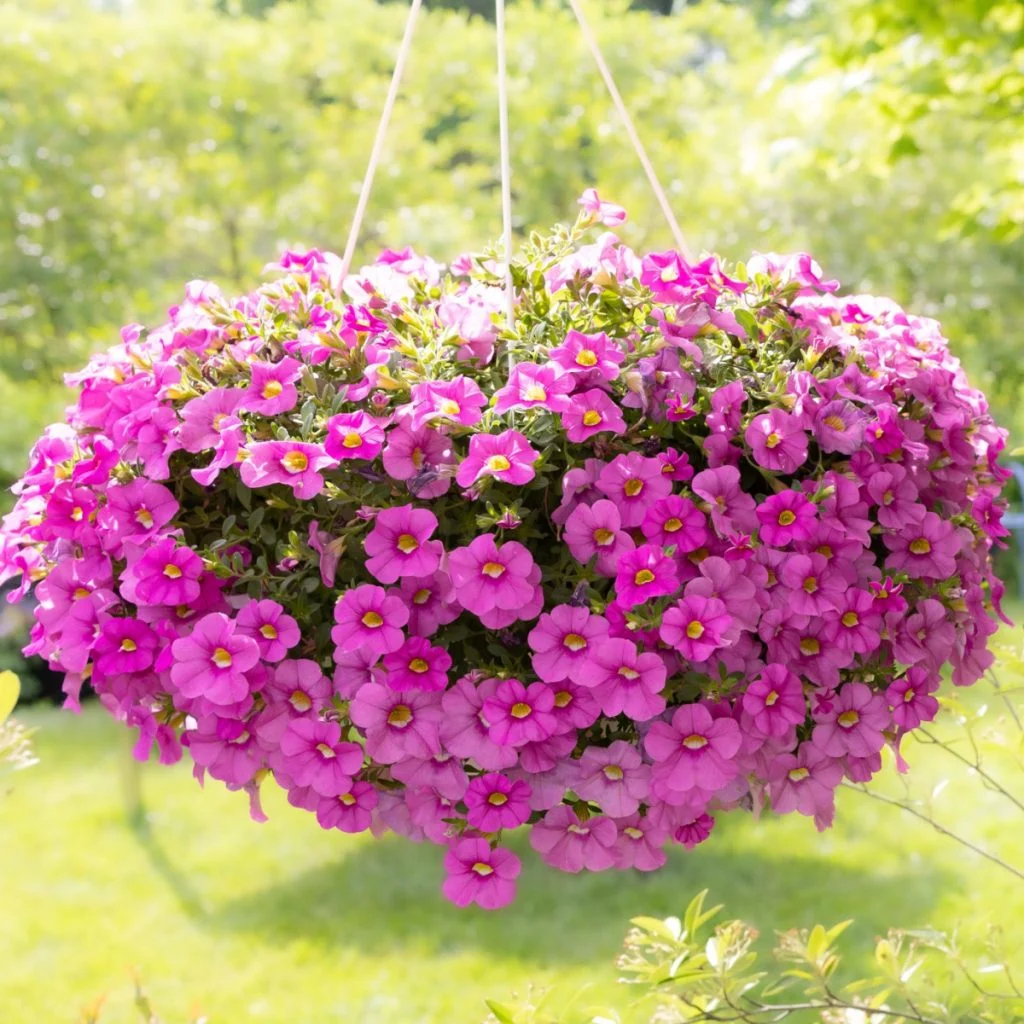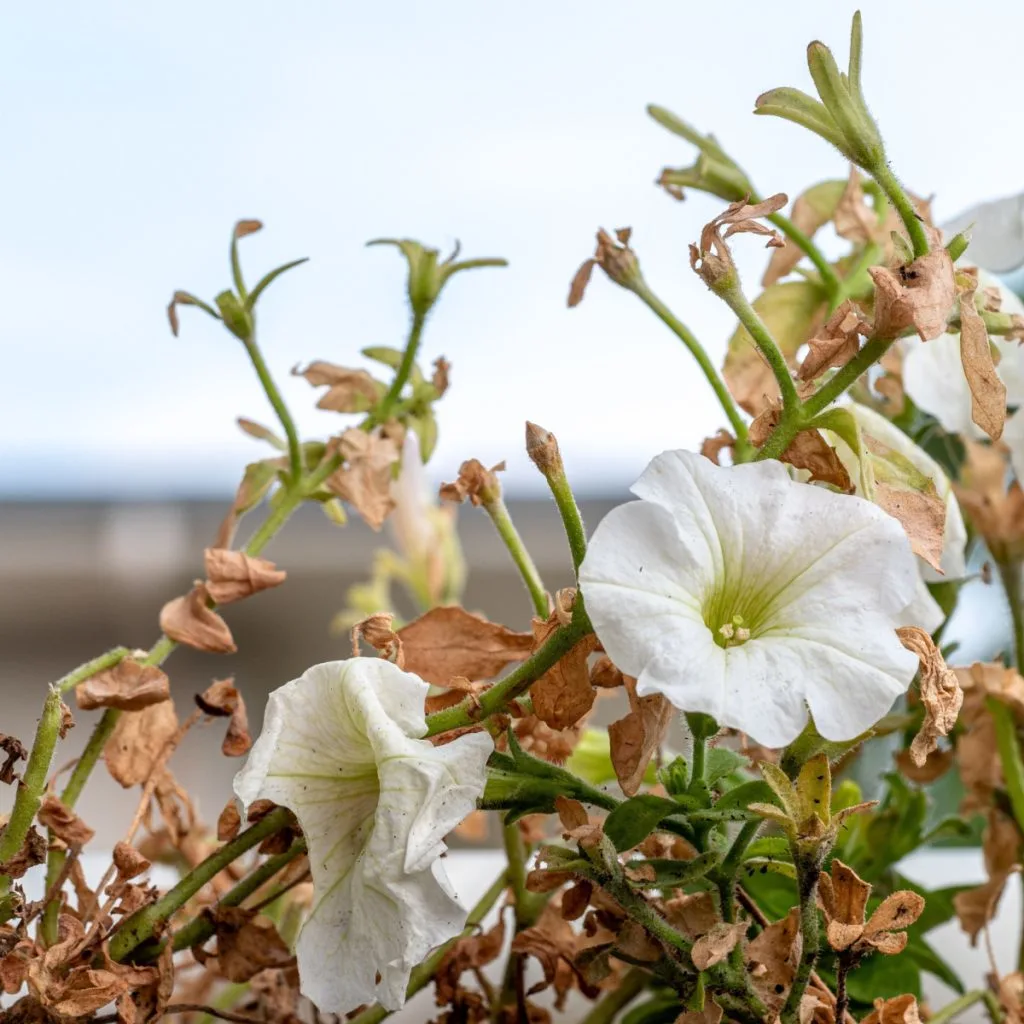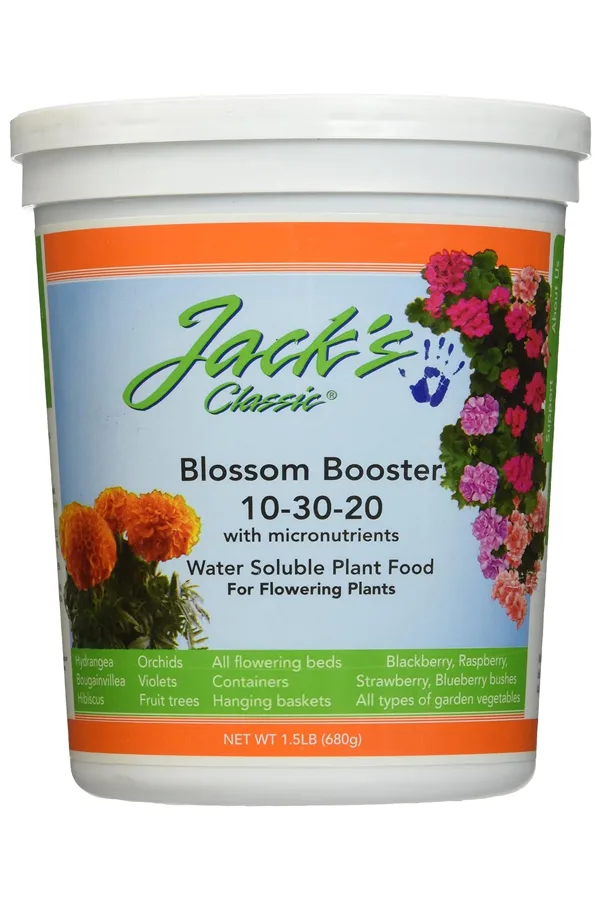Looking for a few tips and tricks to fertilize your hanging baskets in the middle of summer to bring them back to life?
Hanging baskets can bring so much beauty and color to porches, patios, and decks, especially in the early part of the growing season. But as summer sets in – especially by mid to late summer – many hanging baskets begin to fade. And they go down hill fast!
Most gardeners assume the hot summer sun or heavy rainfall is to blame. And while those can certainly have an impact, the most common reason hanging baskets begin to struggle in summer is simply from a lack of nutrients.

By the time July and August arrive, most of the energy from the original potting soil is long gone. Even worse, the plants have often filled every inch of the basket with their roots, making it hard for them to take in water and nutrients.
But here’s the good news – those tired and faded hanging baskets can bounce back quickly with the right fertilizing plan. And it doesn’t require expensive products or complex steps. All it takes is a shift in how and how often you feed your plants during the summer months.
The Best Way To Fertilize Hanging Baskets In Summer
Why Hanging Baskets Struggle In Summer
When hanging baskets are first planted in the spring, they usually have plenty of room in the soil for their roots to grow. On top of that, most commercial potting mixes contain a small amount of fertilizer. That, of course, help the plants get off to a strong start.
But as the weeks go by, all of that changes. The plants use up the nutrients in the soil. Their roots spread out and fill the entire basket. With no space left and no nutrients to draw from, the plants begin to slow down. Blooms become fewer and farther between, and leaves lose their deep green color. If the weather is hot, the stress on the plant increases even more.
Unfortunately, many gardeners don’t realize this is happening. They may continue watering their baskets daily, thinking they’re doing the right thing. But without nutrients, water alone isn’t enough.

Hanging baskets need food to keep producing flowers and staying strong. And because they’re growing in a small, confined space, they need that food delivered in a different way than plants growing in flowerbeds or the ground.
Why You Need To Fertilize Hanging Baskets Differently In The Summer
Fertilizing hanging baskets in the spring and early summer is quite easy. You can apply a general-purpose fertilizer every couple of weeks, and the plants respond well. But by mid to late summer, that same plan just doesn’t work.
The reason is simple. The roots are now completely packed into the basket, and the plants are under more stress from heat and sun.
When roots fill a container, they have less space to absorb water and nutrients. If you try to fertilize with a strong dose, the plant may not be able to absorb it properly. Even worse, the fertilizer can burn the roots and cause more harm than good. That’s why it’s so important to adjust how you fertilize during the summer months.
The answer? Simply switch from strong, occasional feedings to gentle, frequent ones. This method supplies a steady flow of nutrients without overwhelming the roots. It’s much easier for the plant to take in. Best of all, it keeps the growth and blooms coming on strong.
Listen In Below To Our Podcast On Fertilizing Hanging Baskets!
The Best Kind Of Fertilizer For Feeding Summer Baskets
When choosing a fertilizer for summer feeding, it’s important to look for one that’s designed to promote flowering. This means finding a formula that is higher in phosphorous and potassium than nitrogen.
The numbers on a fertilizer label represent the amount of nitrogen (N), phosphorous (P), and potassium (K), in that order. Nitrogen helps with green leafy growth. But too much nitrogen can lead to lots of leaves and very few flowers.
What you want instead is a fertilizer that focuses more on bloom production. Phosphorous helps plants create more flowers and stronger roots. Potassium helps with overall plant health and bloom strength.
A good example of a fertilizer mix for hanging baskets would be something like 10-20-20 or 10-30-20. These types of fertilizers are often labeled as “bloom booster” or “flower enhancer.” And in the summer, they can make a huge difference in how your baskets perform. Affiliate Link: Jack’s Classic 10-30-20 Blossom Booster Water-Soluble Fertilizer
It’s also best to always use a liquid form of fertilizer. Liquid fertilizers deliver nutrients quickly and directly to the roots. This is perfect for hanging baskets, where nutrients can be lost quickly from watering and rain.

When mixed correctly and applied gently, liquid fertilizers can restore tired plants in a matter of days.
How To Mix And Apply Fertilizer In Summer
Now that you have the right kind of fertilizer, the next step is mixing and applying it correctly. As mentioned earlier, the roots of summer baskets are usually very full and tightly packed. That means they need smaller, more regular doses of fertilizer to absorb it safely.
Instead of following the normal strength listed on the fertilizer package, mix your liquid fertilizer at just one-fifth of the recommended strength. If the label calls for one teaspoon per gallon, simply mix one-fifth of that.
This lower concentration is easier for the plants to take in, and it reduces the risk of overfeeding. Once mixed, apply the fertilizer every other day when you water. This method mimics how plants would receive nutrients in nature – small, regular doses that keep the plant constantly fed.
It’s called trickle feeding, and it works extremely well for hanging baskets in the summer. Be sure to apply the liquid directly to the soil and not the foliage.
You want the nutrients to reach the roots, where they’re needed most. If your baskets have dried out, water them lightly with plain water first, and then follow up with the fertilizer. This helps the roots absorb the food more efficiently.

A Few Extra Tips To Help Baskets Recover
Along with fertilizing, there are a few other simple steps you can take to help your baskets come back to life.
First, remove any dead or fading flowers. This process, known as deadheading, tells the plant to produce new blooms instead of trying to create seeds. It also keeps the basket looking neat and tidy. See our article: How To Deadhead Annual Flowers – Get More Blooms From Your Plants!
Second, prune back any long, straggly stems. Cutting back these stems by one-third to one-half encourages new, fuller growth. Don’t be afraid to trim. It may look a little bare at first, but the results will come quickly. Especially when you’re feeding the plant regularly.
Finally, make sure your baskets are draining well. If excess water is pooling at the bottom of the container, it can cause root rot and prevent the roots from taking in nutrients. Make sure there are drainage holes in the bottom of the basket, and never let it sit in a saucer of standing water.
With these steps and the right fertilizing plan, your baskets can go from tired and faded to blooming full again in an instant!
Simple Garden Life
Follow Our Facebook Page For Even More Great Tips! Simple Garden Life Facebook Page
Simple Garden Life is a website dedicated to keeping gardening fun, simple and enjoyable! We publish two new articles each week along with a new garden podcast episode every two weeks. This article may contain affiliate links.
